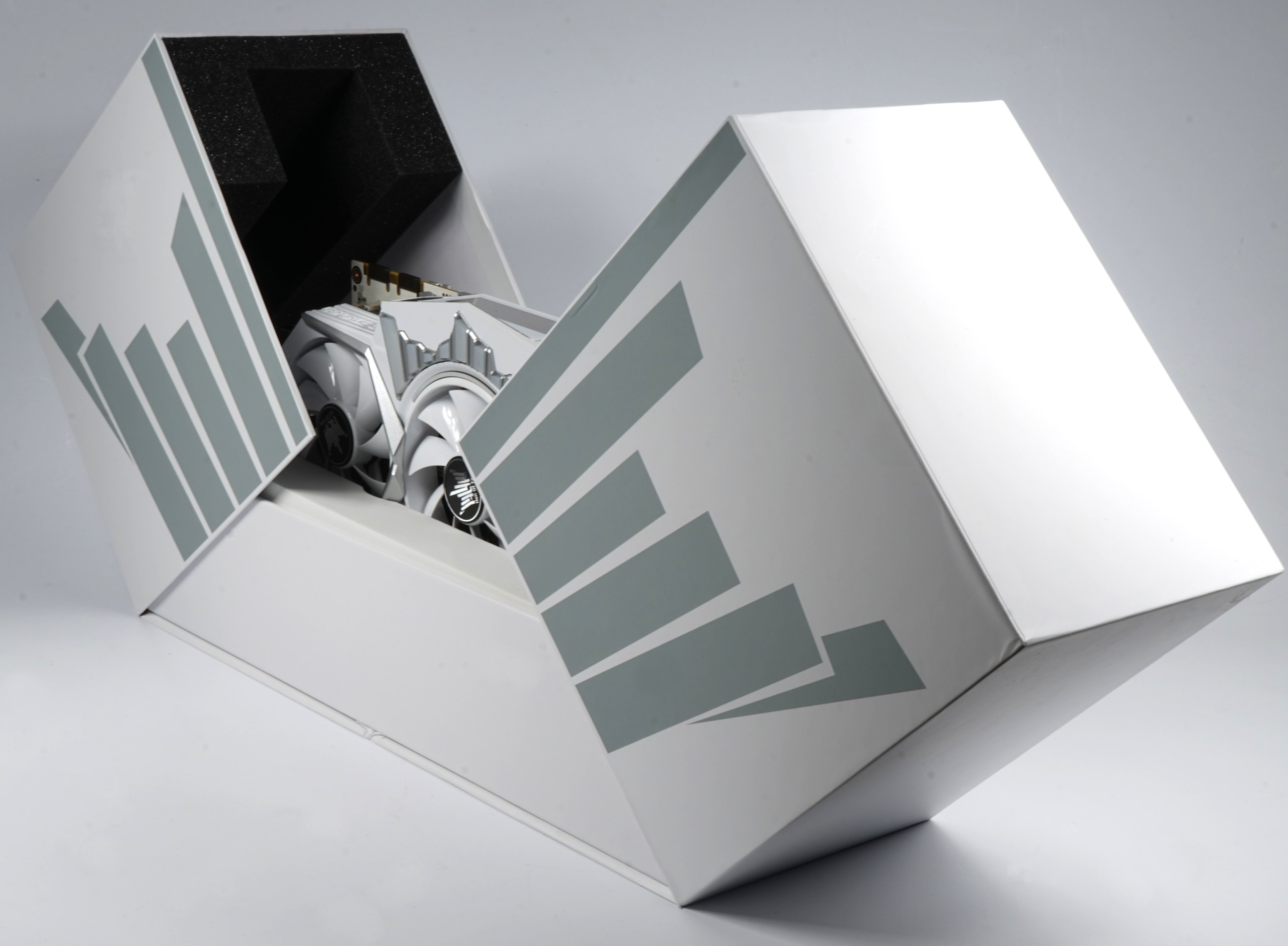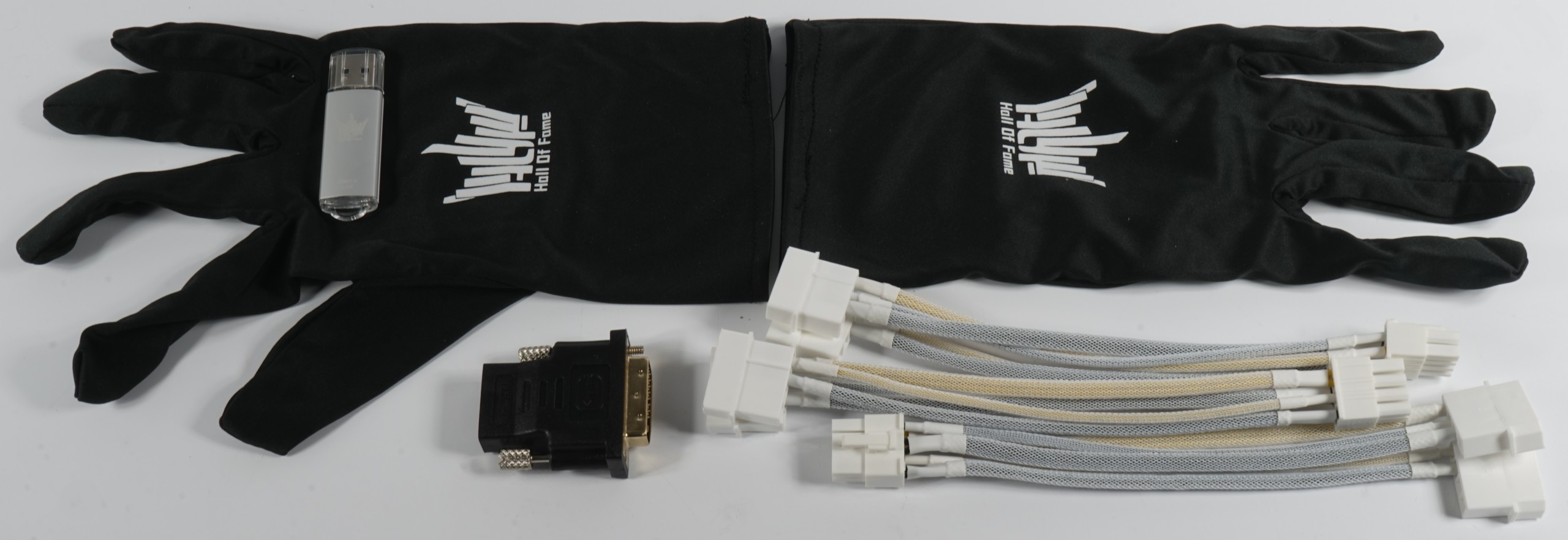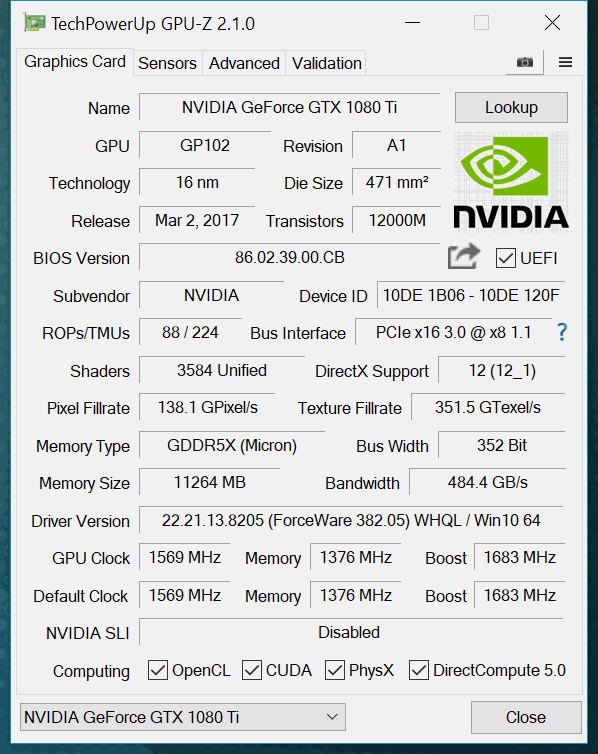Early Verdict
There's a lot to like about Galax's snow white GeForce GTX 1080 Ti HoF. Just be aware of its large dimensions as you plan your upgrade. What's more, the card is only available through Galax's website (at almost Titan Xp pricing, no less).
Pros
- +
Visually unique
- +
Relatively quiet
- +
Good thermal performance
- +
Fast
Cons
- -
On/off fan pulse issue
- -
Unnecessarily hot memory/VRM
- -
High price
- -
Limited availability
Why you can trust Tom's Hardware
Features & Specifications
The word "subtle" definitely doesn't come to mind when describing the appearance of Galax's GeForce GTX 1080 Ti Hall of Fame (HoF) edition graphics card. Even its packaging starts out bold. The card itself is a real behemoth. Not only is it physically large, but it's heavy as well. Go big or go home, right?
Since the actual performance of any third-party card depends on the GPU Boost frequency it can sustain, and thus on cooling, power limits, and processor quality, any review that relies on bar charts is little more than a snapshot of a single specimen. That's why we're putting our emphasis on the actual implementation of each model. To that end, a lot of equipment goes into thoroughly documenting a graphics card's behaviors. If you'd like a peek at what goes into such an evaluation, check out our Nvidia GeForce GTX 1080 Ti 11GB Review. It makes for a good baseline on which Galax builds.
Specifications
Unboxing, Dimensions & Interfaces
Galax packages this beast in a visually impressive box with two sideways-opening wings as cover. As you might imagine, this makes opening the HoF for the first time an intensely satisfying experience. But of course, it's what's inside that counts...
The bundle includes several accessories. However, for safety reasons, it would have been better off without the three Molex-to-eight-pin adapters. The combination of their 20-gauge wires and an inexpensive power supply could turn the installation into a fire hazard. And unnecessarily so, since the number of PCIe connectors you find on PSUs typically correspond to their real power output. No adapter is able to magically generate power where there was none before. If you're interested in a Galax GeForce GTX 1080 Ti HoF card, do the right thing and pair it up with a capable enthusiast-oriented PSU.
As a nice gimmick, the box comes with a so-called "LuminHold" made of acrylic glass. It provides additional RGB lighting, and can be screwed to the expansion slot and connected to the graphics card for direct lighting control. Galax's software for this is not included; instead, you'll need to download that separately. The pictured USB stick only holds the manuals as PDF files, as well as Nvidia's GeForce Experience utility.
With a hefty weight of 1.689 kg, an above-average length of 31.8cm (measured from the slot bracket's outer edge to the shroud's back), an extreme height of 14.5cm (from the top of the motherboard slot to the upper edge of the shroud), and a portly width of 5.4cm, this 2.5-slot form factor effectively gobbles up three expansion slots to become the largest card we've tested. Furthermore, the backplate requires another 0.5cm of clearance on the other side, which could affect enthusiasts with large CPU coolers.
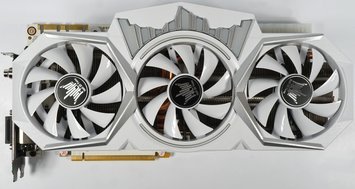
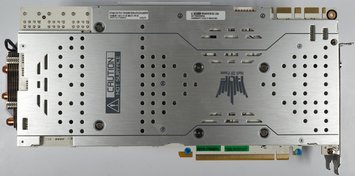
Whether you like the shroud's mix of plastic parts is a matter of personal taste. The clean white look is still a relatively rare sight, though. To that end, the GeForce GTX 1080 Ti HoF's appearance follows the established design of previous HoF cards. So, apart from the excessive dimensions, there are no real visual surprises.
Get Tom's Hardware's best news and in-depth reviews, straight to your inbox.
The backplate is made of brushed aluminum, coated in black on the inside, and situated in such a way that it provides a passive contribution to the overall cooling solution.
Up top, you'll find a back-lit LCD and three eight-pin auxiliary power connectors. Those PCIe connectors are rotated by 180° and positioned at the PCB's end.
The black-and-white display has a rather low resolution. It is designed to either display just a logo, or (once the appropriate software is installed) clock rates, fan speeds, voltages, and more. The effect is certainly unique, though you'll want a windowed case to show it off.
Peeking into the top and bottom reveals that the cooler's fins are oriented vertically. They also reveal the absence of a real VRM heat sink, which would have helped with cooling.
Instead, Galax adds a mounting frame positioned between cooler and board. This frame is meant to provide both additional stabilization and cooling. Unfortunately, its actual implementation is not quite perfect. More on that when we dig into thermal analysis.
The end of the card reveals four 8mm heat pipes for the right part of the cooler structure. At this angle (and from the outside), a fifth 6mm bent heat pipe is not visible.
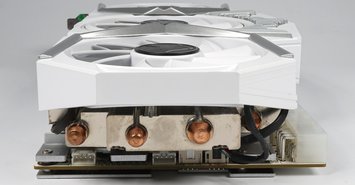
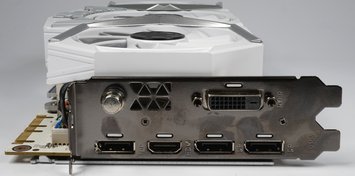
Galax exposes a fairly standard complement of one HDMI 2.0 output, three DisplayPort 1.4-capable connectors, and a dual-link DVI-D port. Of those five interfaces, a maximum of four can be used simultaneously in a multi-monitor setup.
A GPU-Z screenshot provides the most pertinent technical information, even if the GPU Boost values we observed were much higher than Galax's official specifications.
| Header Cell - Column 0 | NvidiaTitan X (Pascal) | NvidiaGeForce GTX 1080 Ti FE | Galax GeForceGTX 1080 Ti Hall Of Fame | NvidiaGeForce GTX 1080 FE | NvidiaGeForce GTX 980 Ti |
|---|---|---|---|---|---|
| GPU | GP102 | GP102 | GP102 | GP104 | GM200 |
| CUDA Cores | 3584 | 3584 | 3584 | 2560 | 2816 |
| Base Clock Rate | 1417 MHz | 1480 MHz | 1569 MHz | 1607 MHz | 1000 MHz |
| Boost Clock Rate | 1531 MHz+ | 1582 MHz+ | 1683 MHz | 1733 MHz+ | 1076 MHz+ |
| Memory Size & Type | 12GB GDDR5X | 11GB GDDR5X | 11GB GDDR5X | 8GB GDDR5X | 6GB GDDR5 |
| Die Size | 471 mm² | 471 mm² | 471 mm² | 314 mm² | 601 mm² |
| Process Technology | 16nm | 16nm | 16nm | 16nm | 28nm |
| Transistors | 12 billion | 12 billion | 12 billion | 7.2 billion | 8 billion |
| Streaming Multiprocessors (SM) | 28 | 28 | 28 | 20 | 22 |
| GFLOPS (Base Clock) | 10,157 | 10,609 | 11,247 | 8228 | 5632 |
| Texture Units | 224 | 224 | 224 | 160 | 176 |
| Texture Fill Rate | 317.4 GT/s | 331.5 GT/s | 351.5 GT/s | 257.1 GT/s | 214 GT/s |
| ROPs | 96 | 88 | 88 | 64 | 96 |
| Pixel Fill Rate | 136 GPix/s | 130.24 GPix/s | 138.1 GPix/s | 114.2 GPix/s | 116.7 GPix/s |
| Memory Data Rate | 10 Gb/s | 11 Gb/s | 11 Gb/s | 10 Gb/s | 7 Gb/s |
| Memory Bus | 384-bit | 352-bit | 352-bit | 256-bit | 384-bit |
| Memory Bandwidth | 480 GB/s | 484.4 GB/s | 484.4 GB/s | 320 GB/s | 336 GB/s |
| L2 Cache | 3MB | 2816KB | 2816KB | 2MB | 3MB |
| TDP | 250W | 250W | 275W (PT) | 180W | 250W |
Test System & Measurement Methods
We explained our test system and methodology in How We Test Graphics Cards. If you want to learn more about the procedures we're using in today's review, have a look at that story. In the time since it was published, we also upgraded our CPU and cooling system to rule out any possible host processing bottlenecks.
A short summary in table-form to provide a quick overview:
| Test Systems & Measurements | |
|---|---|
| System | Intel Core i7-6900K @ 4.3 GHzMSI X99S XPower Gaming TitaniumCorsair Vengeance DDR4-32001x 1TB Toshiba OCZ RD400 (M.2, System SSD)2x 960GB Toshiba OCZ TR150 (Storage, Images)be quiet Dark Power Pro 11, 850W PSUWindows 10 Pro (All Updates) |
| Cooling | Alphacool Eisblock XPXAlphacool Eiszeit 2000 Chiller2x be quiet! Silent Wings 3 PWM (Closed Case Simulation)Thermal Grizzly Kryonaut (Used when Switching Coolers) |
| Case | Lian Li PC-T70 with Extension Kit and ModsConfigurations: Open Benchtable, Closed Case |
| Monitor | Eizo EV3237-BK |
| Power Intake | Contact-free DC Measurement at PCIe Slot (Using a Riser Card)Contact-free DC Measurement at External Auxiliary Power Supply CableDirect Voltage Measurement at Power Supply2x Rohde & Schwarz HMO 3054, 500MHz Digital Multi-Channel Oscilloscope with Storage Function4x Rohde & Schwarz HZO50 Current Probe (1mA - 30A, 100kHz, DC)4x Rohde & Schwarz HZ355 (10:1 Probes, 500MHz)1x Rohde & Schwarz HMC 8012 Digital Multimeter with Storage Function |
| Thermography | 1x Optris PI640 80Hz Infrared Camera + PI ConnectReal-Time Infrared Monitoring and Recording |
| Acoustics | NTI Audio M2211 (with Calibration File, Low Cut at 50Hz)Steinberg UR12 (with Phantom Power for Microphones)Creative X7, Smaart v.7Custom-Made Proprietary Measurement Chamber, 3.5 x 1.8 x 2.2m (L x D x H)Perpendicular to Center of Noise Source(s), Measurement Distance of 50cmNoise Level in dB(A) (Slow), Real-time Frequency Analyzer (RTA)Graphical Frequency Spectrum of Noise |
MORE: Best Graphics Cards
MORE: Desktop GPU Performance Hierarchy Table
MORE: All Graphics Content

Igor Wallossek wrote a wide variety of hardware articles for Tom's Hardware, with a strong focus on technical analysis and in-depth reviews. His contributions have spanned a broad spectrum of PC components, including GPUs, CPUs, workstations, and PC builds. His insightful articles provide readers with detailed knowledge to make informed decisions in the ever-evolving tech landscape
-
JonDol "What's more, the card is only available through Galax's website (at almost Titan Xp pricing, no less)"Reply
And yet I'd buy this one rather than the Xp: while I have no problems with Titan's price I do have a big problem with its noise and cooling and for this reason I think that Nvidia's decision to not open the Titan to OEMs (and their better custom cooling solutions) was a really bad one. -
AndrewJacksonZA This thing is simply beautiful... I would love to have one. :-)Reply
Thank you for the review, Igor! -
10tacle Whew what a beast! As much as I like the white theme as my next build will be white with blue LEDs, I could never justify paying this premium over my $730 EVGA SC2 Gaming 1080 Ti.Reply -
mac_angel for the GTX 1080ti cards, overclocking is better done by adjusting the curve in Afterburner instead of just adding +xx to the core clockReply -
FormatC Reply
Each card is unique and the curve may differ a lot. I use curves to undervolt my own cards, but this is in detail too much for such a review. The next reader will copy my curves and then bash me because it won't work for him. :)20099153 said:for the GTX 1080ti cards, overclocking is better done by adjusting the curve in Afterburner instead of just adding +xx to the core clock
-
Hal-Jordan I was curious how much they were charging for this. I don't see the price listed anywhere in the text of the article. There's a black "Suggested price..." box at the bottom of the page, with the price listed as "N/A," and the galax website appears to be offline. It seems that an important part of the review was omitted.Reply -
FormatC As we wrote the review, the card was available and the site online. Difficult to say, what happened.Reply -
redgarl Ugly as hell and the Achiles heel of the 1080s is the VRAM. Your card can die after a short time if the cooling solution is not adequate. i would not touch this with a 10 meter stick.Reply -
caustin582 Practical issues aside, Galax needs to fire whoever did the visual design for this card. My god is this thing ugly.Reply
